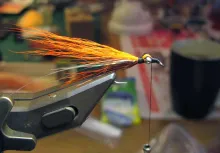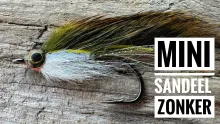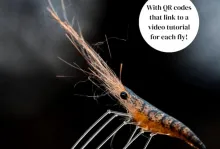Very inspired by the Clouser style as well as the Thunder Creek, but not tied quite as any of the originals. The Clouser-ish will still go in the Clouser Deep Minnow category, and as all these flies it's an excellent and easy-to-tie fly.
This is not really an original fly... more like a variation... one of the hundreds (if not thousands) of derivatives of Bob Clouser's classic Clouser Deep Minnow without which this fly would probably never have seen the light of day.
And if that wasn't enough it also owes a bit to Keith Fulsher's brilliant Thunder Creek style. Theft left and right in other words... as with so many other fly patterns.
A bare hook point
I love the Clouser Deep Minnow, and have always admired its simple and yet ingenious construction. But often when I tie these flies the hair flares too much, and I get a wing, which is much more fan shaped than I like. I fiddled around with different solutions for a while, and finally stumbled over this method, which lets me control the flare of both sides of the fly better than on the original fly.
On the original the last section of the wing is tied in in front of the eyes, but on the opposite side of the hook shank. On my flies it usually flares and covers the hook point, which is brilliant on a fly that fishes on the bottom, since it very likely saves you a lot of snags.
But when I fish the Clouser it's rarely on the bottom, but fishes in the midwater. This means that I don't need the point covered... actually, I'd rather like it completely bare so that it hooks better. Especially when fishing for garfish with their hard bills, this will give a lot more hookups.
Thunder Creek style
I'm also a great liker of the Thunder Creek style of flies, but always have a small battle when reversing the hair to form the head.
One day when tying Clousers, I tried a different and slightly Thunder Creekish approach, tying in the darker wing first, then the light one that passes over the eyes—opposite what's usually done on Clousers.
And I wound up with a Thunder Creekish, Clouserish kind of fly, which looks a bit like both, but is essentially a slender Clouser Deep Minnow. I liked what I saw.
Sure, I know that many tiers can tie really slim Clousers where the hook point is uncovered, but the ones that come from my vice, tend not to. So to control the wings I have now adapted this method of tying Clousers, but realizing the heritage, I have dubbed the fly The Clouserish. Like the original, it's a method more than a pattern, and the color variations are indefinite. Use whatever colors bucktail you have, add some flash and use lighter eyes than the lead dumbbells used on the Clouser Deep Minnow, and you will have a nice, slim streamer and a potentially excellent baitfish imitation.
Tying instructions
|
|
|
|
|
|
|
|
|
|
|
|
|
|
|
|
- Log in to post comments


























Jan, I use Kamasa
Jan,
I use Kamasan B175 and B170 for about 80% of my coastal flies, and even though they will eventually rust, I have flies that have lasted a season's use and flies that have been sitting in my box for several seasons without rusting. The hook has a brassy look (more shiny than bronzed gooks), but must be treated in some way, because it lasts. Black hooks of any sort don't last nearly as long without rusting in my experience.
Martin
Hi Martin,
thanks a
Hi Martin,
thanks again for your gorgeous tying manuals. My question concern the Kamasan B 175 hooks. I am wondering how long they last in the saltwater? Are they black?
Best regards
Jan
This fly is very sim
This fly is very similar to an icelandic streamer known as "the cat" or "katturinn" in icelandic. It is a very popular choice for brown trout, both sea-run and landlocked and is used in a variety of colors.
I like the look of t
I like the look of this streamer, I'll tie a few and see how they look.
If I come up with any interesting variations, I'll post them on the Forum.